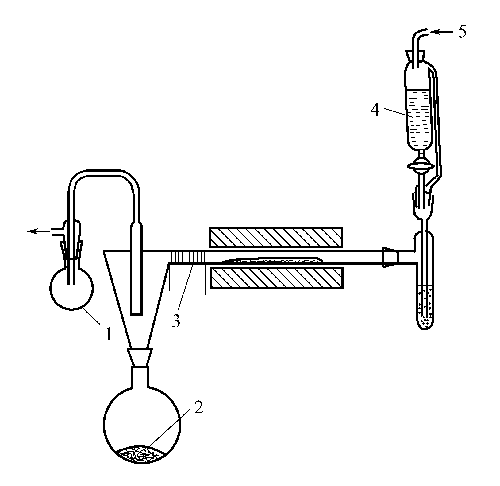Section 1: Product Identification
Chemical Name: Niobium (V) bromide (99.9%-Nb)
CAS Registry Number: 13478-45-0
Formula: NbBr5
EINECS Number: 236-778-5
Chemical Family: metal halide
Synonym: Niobium pentabromide, Columbium pentabromide
Section 2: Composition and Information on Ingredients
Ingredient CAS Number Percent ACGIH (TWA) OSHA (PEL)
Title Compound 13478-45-0 100% no data no data
Section 3: Hazards Identification
With moisture, this material becomes a strong, corrosive acid. The liquid and its vapor are extremely corrosive
Emergency Overview:
to skin, eyes, mucous membranes and respiratory tract.
Primary Routes of Exposure: Ingestion, inhalation, eyes and skin
Eye Contact: Severe corrosive to the eyes. Exposure can lead to permanent eye damage.
Skin Contact: Corrosive to skin. Contact can lead to redness, pain, blistering, ulceration, and scar formation.
Material releases corrosive fumes. Severe burning of the mucous membranes and lungs. Pulmonary edema
Inhalation:
may occur.
Product is a highly corrosive acid. Ingestion may cause pain, vomiting, burns of mouth and throat, and
Ingestion:
ulceration of gastrointestinal tract.
Acute Health Affects: Severe corrosive to eyes, skin, mucous membranes and respiratory tract. Ingestion may be fatal.
Repeated or prolonged exposure to bromides by any route may cause skin rashes (bromaderma) and central
Chronic Health Affects:
nervous system depression, including ataxia, psychoses, memory loss, irritability, and headache.
NTP: No
IARC: No
OSHA: No
SECTION 4: First Aid Measures
Immediately flush the eyes with copious amounts of water for at least 10-15 minutes. A victim may need
Eye Exposure:
assistance in keeping their eye lids open. Get immediate medical attention.
Wash the affected area with water. Remove contaminated clothes if necessary. Seek medical assistance if
Skin Exposure:
irritation persists.
Remove the victim to fresh air. Closely monitor the victim for signs of respiratory problems, such as difficulty
Inhalation:
in breathing, coughing, wheezing, or pain. In such cases seek immediate medical assistance.
Seek medical attention immediately. Keep the victim calm. Give the victim water (only if conscious). Induce
Ingestion:
vomiting only if directed by medical personnel.
SECTION 5: Fire Fighting Measures
Flash Point: not applicable
Autoignition Temperature: none
Explosion Limits: none
Extinguishing Medium: None. Material is non-flammable.
If this product is involved in a fire, fire fighters should be equipped with a NIOSH approved positive pressure
Special Fire Fighting Procedures:
self-contained breathing apparatus and full protective clothing.
Hazardous Combustion and none
Decomposion Products:
Unusual Fire or Explosion Hazards: No unusual fire or explosion hazards.
SECTION 6: Accidental Release Measures
Small spills can be mixed with powdered sodium bicarbonate, lime, or calcium carbonate and swept up. Avoid
Spill and Leak Procedures:
raising dust.
SECTION 7: Handling and Storage
Store solid in a tightly sealed container away from moisture. Handle in a fume hood under a dry atmosphere of
Handling and Storage:
air or nitrogen. Prolonged exposure to the atmosphere may degrade the product.
SECTION 8: Exposure Controls and Personal Protection
Eye Protection: Always wear approved safety glasses when handling a chemical substance in the laboratory.
Skin Protection: Wear protective clothing and gloves. Consult with glove manufacturer to determine the proper type of glove.
Ventilation: The solid may form corrosive vapors. It should be handled in an efficient fume hood.
If in form of fine dust and ventilation is not available a respirator should be worn. The use of respirators
Respirator:
requires a Respirator Protection Program to be in compliance with 29 CFR 1910.134.
Ventilation: The solid may form corrosive vapors. It should be handled in an efficient fume hood.
Additional Protection: No additional protection required.
SECTION 9: Physical and Chemical Properties
Color and Form: -100 mesh reddish-brown pwdr.
Molecular Weight: 492.49
Melting Point: 150°
Boiling Point: 361.6°C
Vapor Pressure: no data
Specific Gravity: no data
Odor: pungent odor
Solubility in Water: reacts with water
SECTION 10: Stability and Reactivity
Stability: moisture sensitive
Hazardous Polymerization: no hazardous polymerization
Conditions to Avoid: contact with moisture
Incompatibility: water, mineral acids and active metals
Decomposition Products: none
SECTION 11: Toxicological Information
RTECS Data: No information available in the RTECS files.
Carcinogenic Effects: no data
Mutagenic Effects: no data
Tetratogenic Effects: no data
SECTION 12: Ecological Information
Ecological Information: No information available
SECTION 13: Disposal Considerations
Disposal: Dispose of according to local, state and federal regulations.
SECTION 14: Transportation
Shipping Name (CFR): Corrosive solids, N.O.S.
Hazard Class (CFR): 8
Additional Hazard Class (CFR): NA
Packaging Group (CFR): I
UN ID Number (CFR): UN# 1759
Shipping Name (IATA): Corrosive solid, N.O.S.
Hazard Class (IATA): 8
Additional Hazard Class (IATA): NA
Packaging Group (IATA): I
UN ID Number (IATA): UN# 1759
SECTION 15: Regulatory Information
TSCA: Listed in the TSCA inventory.
SARA (Title 313): Title compound not listed.
Second Ingredient: none
SECTION 16 - ADDITIONAL INFORMATION
N/A
 基本信息
展开↓
基本信息
展开↓  生产制备方法及用途展开↓
生产制备方法及用途展开↓
 物化性质展开↓
物化性质展开↓  安全信息展开↓
安全信息展开↓  合成路线查看所有的合成路线
合成路线查看所有的合成路线 毒理性展开↓
毒理性展开↓  MSDS 展开↓
MSDS 展开↓ 分子结构与计算化学数据展开↓
分子结构与计算化学数据展开↓